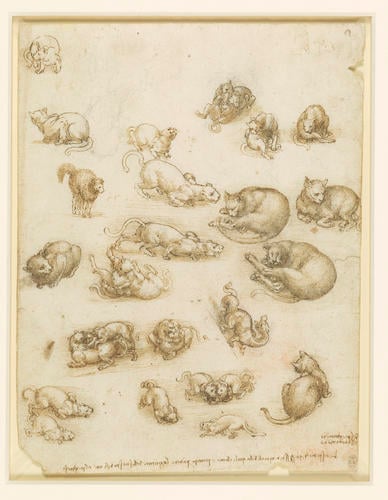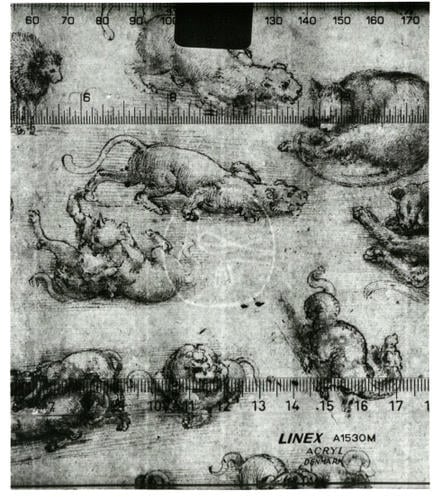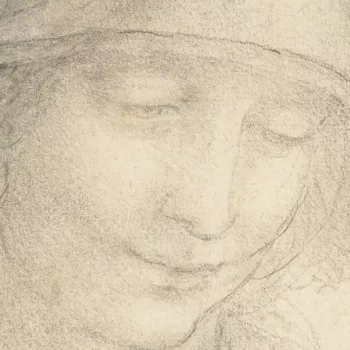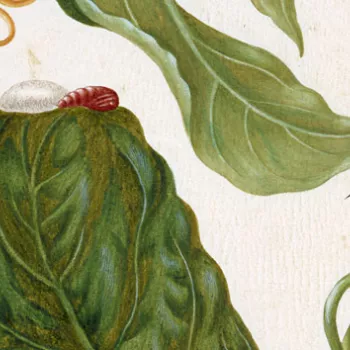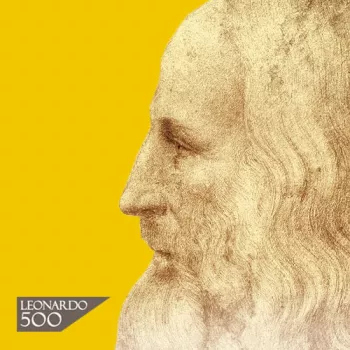Cats, lions, and a dragon c.1517-18
Black chalk, pen and ink, wash | 27.0 x 21.0 cm (sheet of paper) | RCIN 912363
-
A sheet of more than twenty drawings of cats and lions in a wide variety of positions; lying asleep, sitting, prowling, playing, fighting, and in one case frightened, standing with humped back and fur standing on end; in the lower half, drawn at an odd angle, is a study of a dragon, with its head bent back over its shoulder.
One of the most charming of all of Leonardo's drawings, it covers the full range of his modes from the most stylised and 'Leonardesque', in the coiling dragon, to the most acutely observed and unaffected, in the many studies of domestic cats. The most detailed studies, at centre right, show the cats sleeping, and seem to have been done directly from the life, with the subject motionless; by contrast the depictions of cats fighting had to be visualised on the basis of fleeting impressions. In most of the fights it is difficult to discern which limb belongs to which cat, and in the study at lower centre he has drawn the two cats locked together as a single unit, almost symmetrical, in the manner of a Romanesque carving.
Surrounding the studies of domestic cats are seven drawings of a single lioness, mostly crouching or prowling. Lions were well enough known in Italy at the time – they were, for example, kept in a cage behind the Palazzo della Signoria in Florence, as one of the symbols of the city – and Leonardo shows in these drawings a clear understanding of their anatomy and proportions. But the unifying interest of the sheet is revealed by Leonardo's short and incomplete note at the bottom:
'Of flexion and extension
This animal species, of which the lion is the prince because of its spinal column which is flexible…'
A related sheet of studies of horses (RCIN 912331) carries a similar note, 'The serpent-like movement is the principal action in animals and it is double, the first occurring along its length and the second across its width.' The purpose of these studies is confirmed by a memorandum in his Manuscript E now in Paris, of c.1513-14: 'Write a separate treatise describing the movements of animals with four feet, among which is man, who likewise in his infancy crawls on all fours.'
It is clear, therefore, that Leonardo's primary concern in these drawings was the variety of positions and movements attainable by members of the cat family, and that the dragon was added simply as a still more extreme case (as limited only the artist's imagination rather than by real anatomy). But while Leonardo expressed an interest in writing a treatise on animal movement – perhaps as displacement therapy for his treatise on human anatomy, work towards which had stalled at this time – there is no evidence that such a treatise was ever developed in any detail.
Two sheets of copies after the motifs on this sheet were most recently at Christies, NY, 28 Jan 2021, lots 2-3, where attributed to Francesco Melzi; but of low quality, and not demonstrably by Melzi.Provenance
Bequeathed to Francesco Melzi; from whose heirs purchased by Pompeo Leoni, c.1582-90; Thomas Howard, 14th Earl of Arundel, by 1630; probably acquired by Charles II; Royal Collection by 1690
-
Creator(s)
Acquirer(s)
-
Medium and techniques
Black chalk, pen and ink, wash
Measurements
27.0 x 21.0 cm (sheet of paper)
Markings
watermark: Bird in a circle. Close to Briquet 12219. (Bird in a circle, Cod. Arun., ff 131-132) [-]




